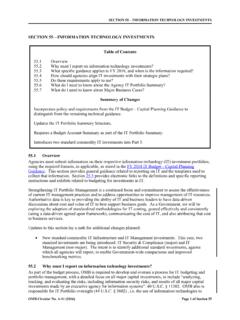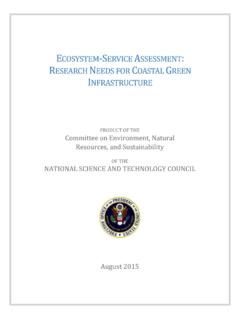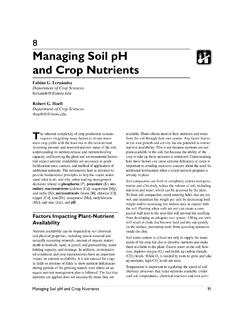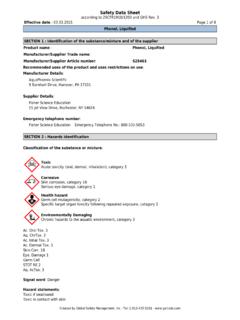Transcription of Coal Ash: Characteristics, Management and Environmental …
1 Technical Update -Coal Combustion Products - Environmental Issues coal ash : Characteristics, Management and Environmental Issues Table of Cantents Introduction Formation and Physical Characteristics Fly Ash Bottom Ash/Boiler Slag Chemical Composition Beneficial Use Disposal Environmental Issues leaching Windblown Ash Mercury Radioactivity References 2 2 3 5 6 7 7 8 9 9 10 Coal-fired power plants in the United States produce more than 92 million tons of coal ash per year. About 40% is beneficially used in a variety of applications, and about 60% is managed in storage and disposal sites.
2 This technical update summarizes information and data on the physi cal and chemical characteristics of coal ash , beneficial use applications, disposal practices, and ( Management practices (Q mitigate Environmental concerns. Introduction The electric utility industry burns more than 1 billion tons ofcoal annually, with coal-fired generation supplying about 50% of the electricity used in the United States. The solids collected from t he furnace and removed from the flue gas after the coal is combusted are collectively re ferred to as coal combustion products (CCPs), and can be broadly categorized as coal ash and flue gas desulfurization (FGD ) solids.))
3 Information on FGD gypsum, the solid product from wet FGD systems with forced oxidation, is presented in a companion technical update document. Coal is composed primarily ofcarbon and hydrogen, but all coal also contains some mineral mat ter (for example, clays, shales, quartz, and calcite); the percentage varies by coal type and source. coal ash is the mineral maner that is collected after the coal is combusted, along with some un burned carbon. The amount ofcoal ash produced at a power plant depends on the volume ofcoal burned, the amount of mineral marrer in the coal, and the combusrion conditions.
4 In 2007, coal-fired power plants produced about 92 million tons ofcoal ash, including 72 million tons of fly ash, 18 million tons of bottom ash, and 2 million tons of boiler slag. 1 Formation and Physical Characteristics The physical and chemical propenies of coal ash are determined by reactions thar occur during the high-temperamre combustion of the coal and subsequent cooling of the flue gas. A consider able amount of research has gone into understanding how coal ash forms, its characteristics, and how it weathers in the environment.
5 Copyright 2009 Electric Power Research Institute September 2009 Fly Ash Fly ash refers to the lightweight particles that travel with the flue gas as it exits (he furnace and moves away from the high-temperature combustion zone. Power plams are equipped with particulate collection devices, either e1ec([osr3ric precipitators (ESPs) or baghouses, designed to remove nearly all of t he Fly ash from the flue gas prior to the stack to prevent it from being emit (cd to the atmosphere (F igure 1) . An ESP uses eiecnically charged wires and plates to capture the fly ash; baghouses use fabric filters, similar to vacuum cleaner bags.)))]
6 Dry fly ash collected in (he ESP or baghouse is then either pneumatically conveyed to a hopper or storage silo (dry manage ment), or mixed with watet and sluiced through a series of pipes CO an on-site impoundment (wet Management ) . ( Bottom Fly Ash FG D Gypsum Stack Ash/Slag Collection Collection Collection Figure 1. Typical power plant layout showing location of fly ash and bottom ash coffecfion. Fly ash particles are composed mainly of amorphous or glassy aluminosilicates. However, the particles also contain some crystalline compounds that either pass through the combust ion zone unchanged or are formed at high temperatures.))
7 Elements such as arsenic and selenium that be come volatile at high temperatures, preferentially condense on the sur face of the ash particles as the flue gas cools. Fly ash particles are typically spherical in shape, either solid or with vesicles (Figure 2). A small percentage are thin-walled hollow particles called cenospheres. The particles are fine-grained, typically silt-sized, ranging from 1 to 100 microns in diameter, with median par ticle diameter of 20 to 25 Fly ash is usually tan to dark gray in co lor.
8 Bottom Ash/Boiler Slag Bottom ash consists of heavier particles that fall to the bottom of the furnace (see Figure 1). Bottom ash is also composed primarily of amorphous or glassy alu minosilicate mate rials derived from the melted mineral phases. Most bottom ash is produced in dry-bottom boilers, where the ash cools in a dry state, Boiler slag is a t ype of bottom ash collected in wet-bottom boilers (slag tap or cyclone furnaces, which operate at very high temperatures), where the molten particles are cooled in a water quench.
9 Fly ash is composed mainly of amorphous or glassy aluminosili cates_ Fly ash particles are typically silt-sized spheres, ranging from 1 to 100 microns in diameter. Cool Ash: Characteristics, Management and Environmental Issues 2 Bottom ash is coarser than fly ash, with a sandy texture and particles ranging from about mm to 50 mm in diameter. The properties of fly ash and bottom ash make them useful for a variety of construc tion applications. Figure 2. Scanning electron micrographs of fly ash. (a) Typical spherical morphology of glassy particles.
10 (b) A large hallow sphere formed when entrapped gas expanded during thermal decomposition of calcium carbonate (CaC03) . (c) A particle etched with hydrofluoric acid fo remove surface glass and reveal a shell of interlocking mullite crystals. (d) A typical magnetic spinel mineral (magnetile) separated from ash after removal of encapsulating glass. (e) A fractured ash particle containing numerous vesicles. (f) The accumulation of tiny granules of inorganic oxides, crystals, and coalesced ash on the surface of a larger particle.















